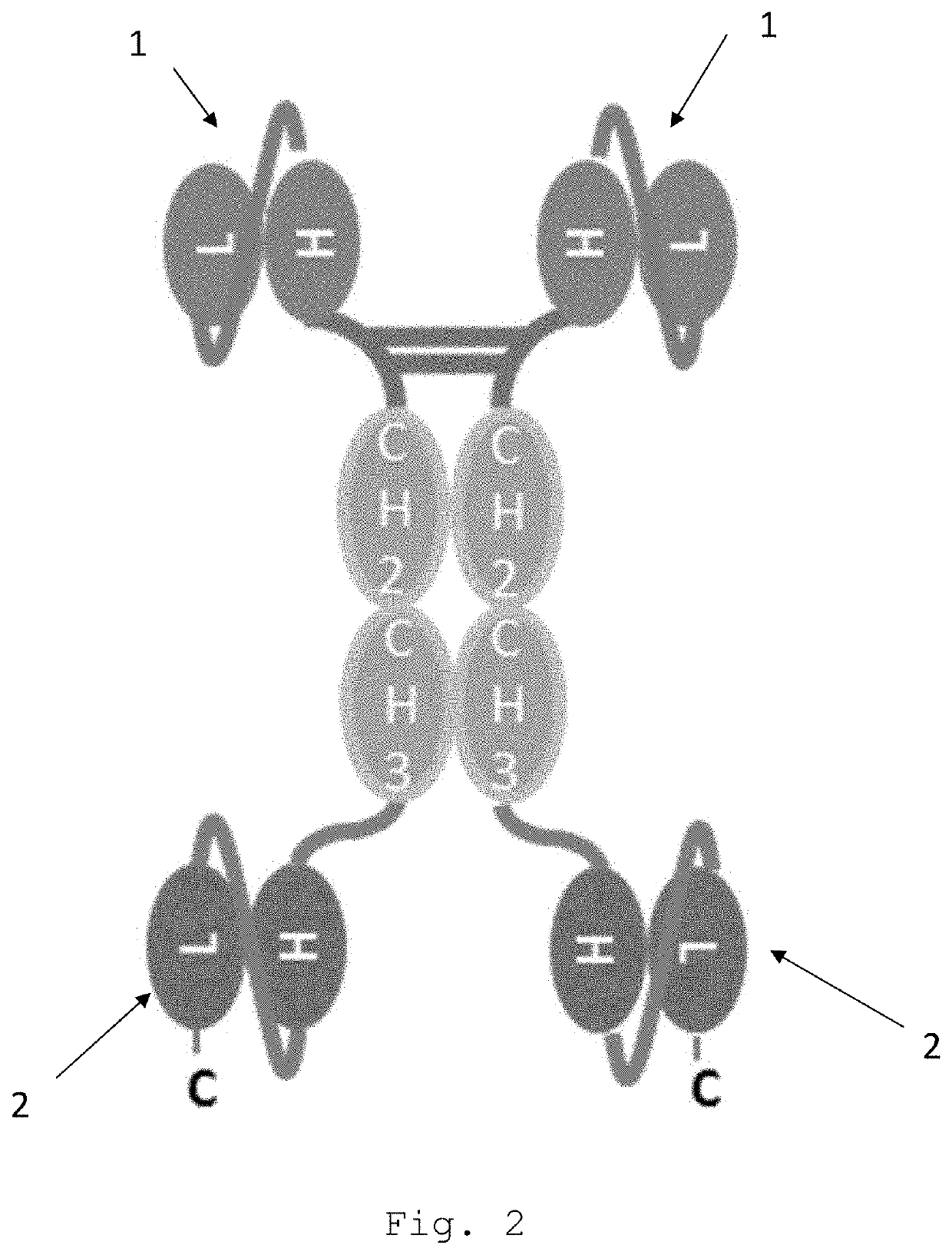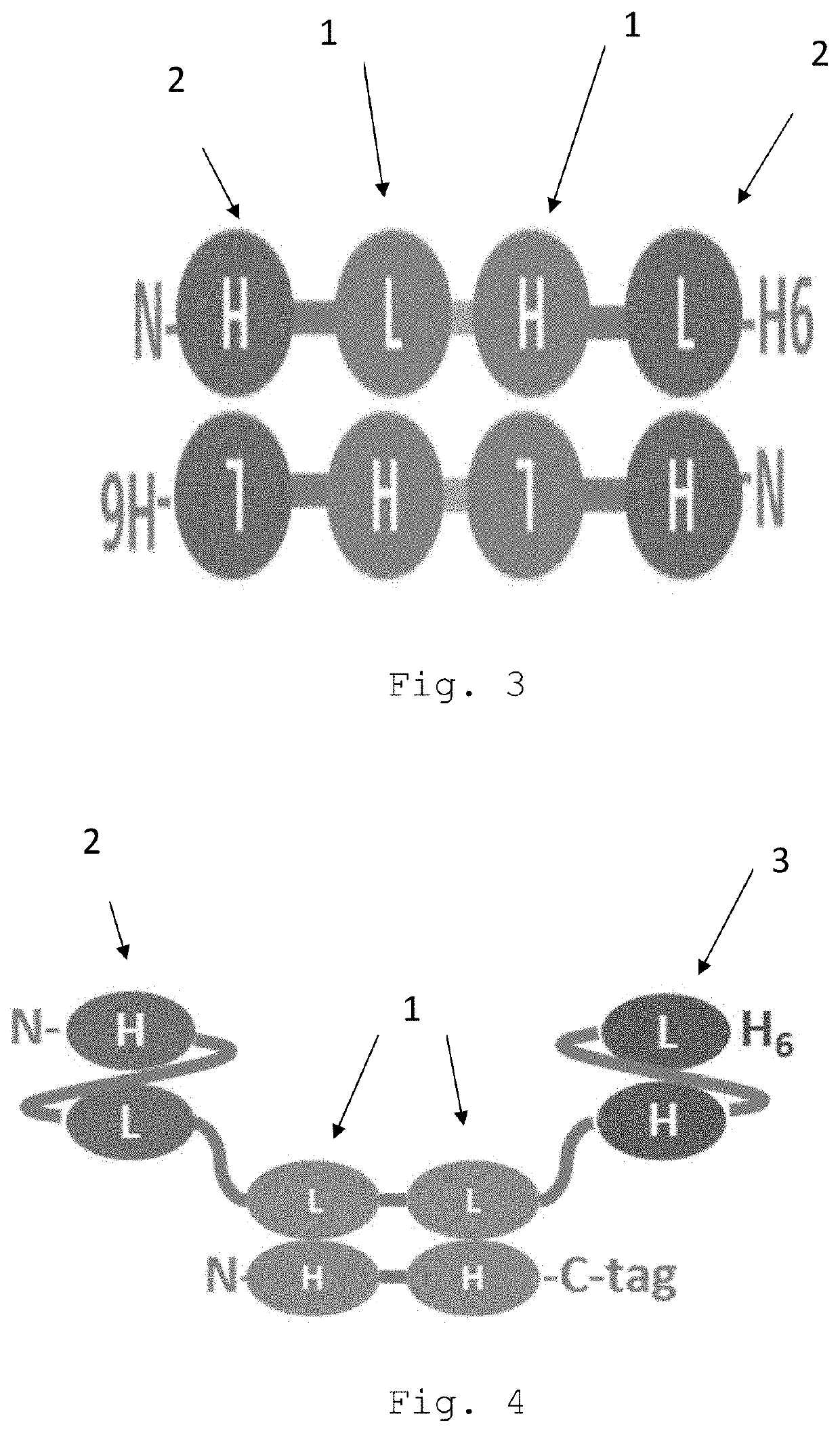Bispecific egfr/cd16 antigen-binding protein
a technology of antigen binding protein and egfr, which is applied in the field of tetravalent, bispecific egfr/cd16a antigen-binding proteins, can solve the problems of affecting the prescription rate of egfr-targeting therapies, severe side effects, and interruption or dose modification of anticancer agents, so as to reduce or no effect on phosphorylation and minor to no skin toxicity
- Summary
- Abstract
- Description
- Claims
- Application Information
AI Technical Summary
Benefits of technology
Problems solved by technology
Method used
Image
Examples
example 1
n and Production of EGFR / CD16A Antigen-Binding Proteins
Material
[0109]
ProductSupplierCat.0.25% Trypsin-EDTALife25200TechnologiesActiCHO Feed-A CDGE HealthcareU15-072ActiCHO Feed-B CDGE HealthcareU05-054CHO-S-SFMIILife12052-114TechnologiesDMSOSigmaD2650DPBSLife14190TechnologiesFCSLife10270-106TechnologiesFlp-In ™-CHO Cell LineLifeR75807TechnologiesHam's F-12 Nutrient MixLife21765-029TechnologiesHT-SupplementLife41065TechnologiesHyClone CDM4 CHO mediumGE HealthcareSH30557Puromycin Dihydrochloride 10FisherA1113803mg / ml in 20 mM HEPES-PufferScientificL-Glutamine (200 mM)Life25030TechnologiesMycoAlert Assay control SetLonzaLT07-518MycoAlert MycoplasmaLonzaLT07-318detection KitOpti-MEMILife31985-047TechnologiesPenicillin / StreptomycinLife15140TechnologiesPhenolred (0.5% solution)SigmaP0290pOG44LifeV600520TechnologiesPolyethylenimine (PEI),Polysciences2396625 kDa, linearSucroseRoth4621ZeocinLifeR250-01Technologies
Generation of the EGFR / CD16A Antigen-Binding Proteins
Tandem Diabody
[0110]The ta...
example 2
[0132]Binding of Bispecific EGFR / CD16A Antigen-Binding Protein to Primary Human NK-Cells in the Presence or Absence of 10 mg / mL Polyclonal Human IgG
Methods:
[0133]Isolation of PBMC from Buffy Coats and Enrichment of Human NK-Cells
[0134]PBMCs were isolated from buffy coats (German Red Cross, Mannheim, Germany) by density gradient centrifugation. The buffy coat samples were diluted with a two-to-threefold volume of PBS (Invitrogen, cat.: 14190-169), layered on a cushion of Lymphoprep (Stem Cell Technologies, cat.: 07861) and centrifuged at 800×g for 25 min at room temperature w / o brake. PBMC located in the interface were collected and washed 3 times with PBS before they were cultured in complete RPMI 1640 medium supplemented with 10% FCS overnight without stimulation. For the enrichment of NK-cells, PBMCs were harvested from overnight cultures and used for one round of negative selection using the EasySep™ Human NK-Cell Enrichment Kit (Stem Cell Technologies, cat.: 19955) for the immun...
example 3
Binding of EGFR / CD16A Tandem Diabody on CHO Cells Expressing Recombinant Human EGFR or EGFRvIII
Cell Binding Assays and Flow Cytometric Analysis
[0137]Aliquots of the indicated cells were incubated with 100 μL of serial dilutions of His-tagged tandem diabodies in FACS buffer (PBS, Invitrogen, cat.: 14190-169) containing 2% heat-inactivated FCS (Invitrogen, cat.: 10270-106), 0.1% sodium azide (Roth, Karlsruhe, Germany, cat.: A1430.0100) for 45 min at 37° C. After repeated washing with FACS buffer, cell-bound antibodies were detected with 10 μg / mL anti-His mAb 13 / 45 / 31-2 (Dianova, Hamburg, Germany, cat.: DIA910-1 MG) followed by 15 μg / mL FITC-conjugated goat anti-mouse IgG (Dianova, cat.: 115-095-062). After last staining step, the cells were washed again and resuspended in 0.2 mL of FACS buffer containing 2 μg / mL propidium iodide (PI) (Sigma, cat.: P4170) in order to exclude dead cells. The fluorescence of 2-5×103 living cells was measured using a Beckman-Coulter FC500 MPL flow cytomet...
PUM
| Property | Measurement | Unit |
|---|---|---|
| Density | aaaaa | aaaaa |
| Density | aaaaa | aaaaa |
| Density | aaaaa | aaaaa |
Abstract
Description
Claims
Application Information
 Login to View More
Login to View More - R&D
- Intellectual Property
- Life Sciences
- Materials
- Tech Scout
- Unparalleled Data Quality
- Higher Quality Content
- 60% Fewer Hallucinations
Browse by: Latest US Patents, China's latest patents, Technical Efficacy Thesaurus, Application Domain, Technology Topic, Popular Technical Reports.
© 2025 PatSnap. All rights reserved.Legal|Privacy policy|Modern Slavery Act Transparency Statement|Sitemap|About US| Contact US: help@patsnap.com



